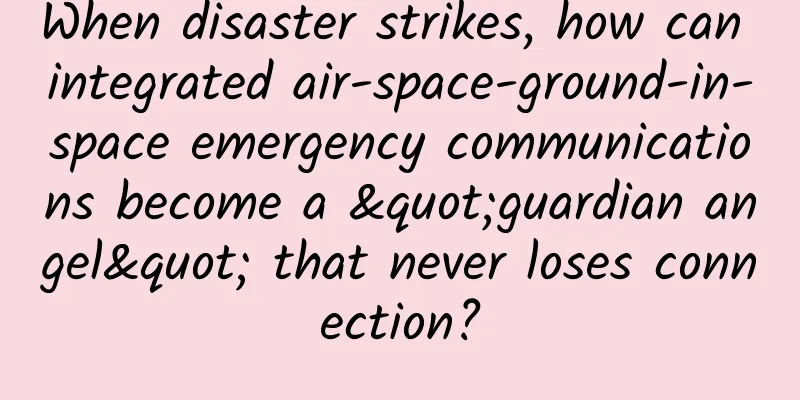When disaster strikes, how can integrated air-space-ground-in-space emergency communications become a "guardian angel" that never loses connection?

|
my country has a vast territory and complex and diverse terrain. In recent years, natural disasters have occurred frequently. Whether it is raging floods, violent earthquakes, sudden wildfires, or fierce typhoons, every disaster has touched the hearts of countless people. In this race against time, the unimpeded flow of information has become the lifeline of rescue work. How to ensure that the disaster-stricken areas can still maintain communication with the outside world under extreme conditions has become an important issue before us. It is based on such needs that the air-ground-integrated emergency communication system came into being. Driven by scientific and technological innovation, it has built a three-dimensional security network that is all-weather, all-regional, and all-disaster, providing strong support for disaster prevention, mitigation, and relief work. 1. Concept Analysis of Air-Ground Integrated Emergency Communications In short, integrated air-ground emergency communication is to organically integrate multiple communication methods such as the sky (satellite communication), the air (drone base station), and the ground (traditional base stations and emergency vehicles) to form an efficient, coordinated, complementary and enhanced communication network system. This system breaks the limitations of traditional emergency communication methods and provides stable and reliable communication services at any time, any place, and any situation, thus winning precious time for rescue work. 2. Why do we need integrated air-ground emergency communications? 1. Responding to extreme natural disasters Natural disasters are often accompanied by severe damage to infrastructure, especially the destruction of communication base stations or their transmission optical cables, which makes the disaster area an "information island". The air-ground-space integrated emergency communication system can be deployed quickly to restore communication between the disaster area and the outside world, providing key information support for rescue command, disaster report, personnel search and rescue, etc. 2. Improve rescue efficiency After a disaster, every minute and every second is crucial. The integrated air-ground-air emergency communication system can achieve rapid information transmission and sharing, helping rescue teams to quickly locate the disaster area, assess the severity of the disaster, and formulate scientific rescue plans, thereby greatly improving rescue efficiency. 3. Ensuring public safety During disasters, the public's demand for information is particularly urgent. The integrated air-ground-space emergency communication system can ensure that the public can promptly understand the disaster situation, receive rescue instructions, and report their own location and safety status, thereby effectively reducing casualties and property losses. 3. Core technologies of air-ground-ground integrated emergency communications 1. Satellite communication technology Satellite communication is a key link in the integrated air-ground-space emergency communication system. It is not limited by the geographical environment and ground infrastructure, and can provide stable and reliable communication services around the world. In the event of communication interruption in the disaster area, satellite communication can quickly build an "information bridge" between the disaster area and the outside world, ensuring the timely transmission of rescue instructions and the real-time feedback of disaster information. 2. UAV communication technology Drones play an important role in emergency communications due to their flexibility and rapid deployment. Especially in areas where roads are blocked and vehicles cannot pass, drones can carry base station equipment into the air to provide temporary communication coverage for disaster areas. At the same time, drones can also carry cameras and other equipment to conduct disaster investigation and emergency search and rescue work. 3. Ground emergency communication technology Ground emergency communication technology mainly includes emergency communication vehicles and portable satellite terminals. Emergency communication vehicles are usually equipped with complete communication equipment and power supply systems, and can be quickly deployed in scenarios with roads and electricity to provide a full range of communication services. Portable satellite terminals are lighter and more flexible, suitable for rapid deployment in complex and changing environments. IV. Application Examples of Air-Ground-Space Integrated Emergency Communications Taking the severe flood disasters in Beijing and Hebei in August 2023 as an example , in the face of sudden flood disasters, China Mobile responded quickly and provided all-round communication guarantee for the disaster area using the integrated air-ground-space emergency communication system. In this rescue operation, China Mobile dispatched a total of 39 satellite communication vehicles, 58 satellite portable stations and 6 drone high-altitude base stations to the disaster-stricken areas, achieving full coverage of the disaster area. 1. Application of large emergency communication vehicles China Mobile deployed large emergency communication vehicles in disaster settlements where there are roads, electricity and transmission. These vehicles are fully equipped and have large capacity. They can provide 2G, 4G, and 5G full-standard and full-band services, and work in conjunction with existing local base stations to meet the needs of people in the disaster area for high-density voice communications and high-speed mobile Internet services. 2. Rapid response of small satellite emergency vehicles Road interruptions and unstable power supply are common in disaster areas such as floods and earthquakes. To this end, China Mobile dispatched small satellite emergency vehicles to the scene. These vehicles have strong off-road capabilities and high integration. A single vehicle is equipped with base station equipment, satellite equipment, and power generation equipment. After arriving at the scene, it only takes 10 minutes to open the service and provide stable communication signals for the surrounding areas. 3. Overcoming obstacles in high-altitude base stations for tethered drones Traditional communication equipment often has difficulty covering complex terrain such as mountainous areas. To this end, China Mobile uses tethered drone high-altitude base stations. These drones can lift the base stations to an altitude of 200 meters, and the signals can pass through obstacles such as hills and reach the worst-hit areas. In this way, China Mobile has successfully solved the communication problems in many remote mountainous areas. 4. The lightweight and integrated satellite base station is "light and quick" In extreme disasters such as earthquakes and mudslides, road conditions may be extremely bad and vehicles cannot pass. In order to eliminate these communication islands, China Mobile has launched a lightweight integrated satellite base station. These devices are small and light, with a full set of equipment weighing less than 15 kilograms and can be stored in a backpack. After being transported to the disaster area by hand or shoulder, the high-density battery-powered base station can start business within 5 minutes, providing valuable communication services to the disaster area. 5. Continuous coverage of medium-sized long-range satellite drones at high altitude base stations In extreme scenarios of power outages, power outages, and network outages, such as areas of continuous communication interruption caused by earthquakes and mountain torrents or maritime emergency scenarios, medium-sized long-range satellite drone high-altitude base stations have become an important means of communication guarantee. These drones are easy to take off and land, can be remotely controlled, easy to transport, and can fly at night. They can take off within 1 hour and fly close to the disaster area, providing long-term continuous and reliable network coverage. At the same time, they can also carry equipment such as three-light cameras and transmit them back to the data processing platform via satellite, providing strong support for tasks such as forest fire prevention and emergency search and rescue. 5. Future Prospects of Air-Ground-Earth Integrated Emergency Communications With the continuous development of science and technology, the integrated air-ground-space emergency communication system will continue to upgrade and improve. In the future, we can expect the following developments: 1. More flexible and convenient communication technology With the development of technologies such as high-throughput satellites and low-orbit satellites, emergency rescue equipment is moving towards miniaturization and broadband. In the future, emergency communication methods for the general public will gradually become popular. When faced with disasters, people can quickly locate, report disaster situations, and command rescue operations. 2. More accurate positioning technology In emergency communications, accurate positioning information is crucial for rescue work. In the future, we can use more advanced positioning technologies (such as the Beidou satellite navigation system) and artificial intelligence technology to accurately locate and track people, materials and equipment in disaster areas. 3. More powerful data processing capabilities With the widespread application of big data and cloud computing technologies, the future integrated air-ground-air emergency communication system will have more powerful data processing capabilities. Through real-time analysis and mining of massive data, we can more accurately assess the disaster situation, predict trends, and formulate scientific disaster prevention or rescue plans. 4. Smarter decision support systems With the help of artificial intelligence and machine learning technologies, we can build a smarter decision support system that can automatically collect and analyze data from various information sources (such as satellite images, videos taken by drones, user feedback on social media, etc.) to provide real-time and accurate decision support for rescue commanders. VI. Conclusion The integrated air-ground-earth emergency communication system is an important support for modern disaster prevention, mitigation and relief work. Driven by scientific and technological innovation, it breaks the limitations of traditional communication methods and provides stable and reliable communication services at any time, any place and any situation. In the future development, we have reason to believe that the integrated air-ground-earth emergency communication system will continue to upgrade and improve, and contribute more to human life safety and social stability. Let us work together to protect the line of life with the power of science and technology! |
>>: Stinging an octogenarian! An aerial killer comparable to a "tiger", but is it really a "pest"?
Recommend
A collection of copywriting taking advantage of the 2018 World Cup. Do you want to join in the fun?
Q: How much does it cost to go to Russia to watch...
Don’t worry about being cheated when shopping on WeChat! Mini Program order management function is now available
As more and more businesses join WeChat Mini Prog...
Are there dragons in your hometown? Maybe there are no dragons in the world...
There are no dragons in this world. Because the C...
Do you have to charge your phone to 100%? This is a big misunderstanding
The reason why most people have to replace their ...
The personal pension system will be released! When will it be released? Who benefits? Attached is the latest news!
In March last year, the Ministry of Human Resourc...
Is breast milk no longer nutritious after 10 months? Can smoking prolong your life? Here are the scientific rumors for March
1. Alcohol and hand sanitizer can inactivate noro...
Understand the real 『REM』 mobile screen adaptation
As a low-key unit of length, rem has been reused ...
Masterpiece: The most exquisite and technically difficult marble sculpture in the world was created by him
In "How did he achieve immortal glory while ...
Which floor of Wenchang Tower is the best?
Wenchang Tower, also known as Wenbi Tower, is gen...
Faced with the cold winter of VR market, Sony, Samsung, Google and HTC decided to join forces to keep warm
Looking back at 2016, the term VR suddenly appear...
Can't help eating? It's not your fault! Maybe there's something wrong with your body.
With the arrival of winter, the weather is gettin...
Ten apps that Android developers can't put down
[51CTO Quick Translation] From IDE to core resour...
WeChat always takes up a lot of memory. Don't clean it up randomly. These four tips are the most practical.
The most painful thing is that WeChat records can...
Live streaming sales process + the latest template for live streaming scripts!
An excellent live broadcast process can ensure th...
New account "The underlying logic of account creation" 100% achieves 500 people online in the live broadcast room
New account "The underlying logic of account...









